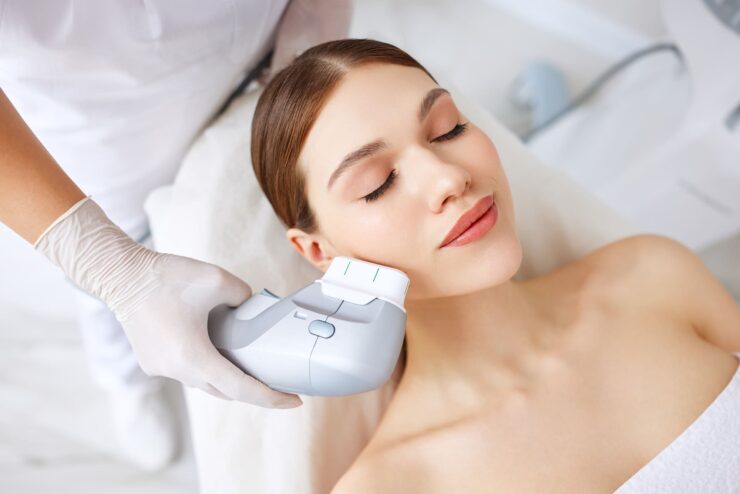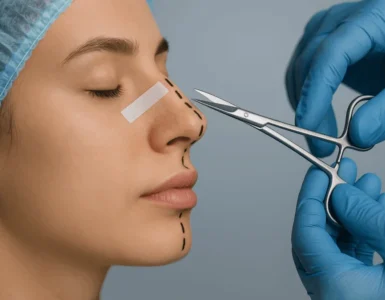Did you know that this advanced skin treatment can reach three precise depths beneath the surface to trigger collagen remodeling without a single incision? High-Intensity Focused Ultrasound (HIFU) delivers thermal energy to depths of 1.5mm, 3.0mm, and 4.5mm under the skin, stimulating collagen renewal for a natural lifting effect.
With HIFU facelift Singapore procedures, the 60–70°C heat generated at these depths causes immediate tissue contraction, followed by gradual collagen regeneration over the next 2–6 months.
HIFU results typically maintain visible improvements for 12-18 months, with some patients experiencing benefits extending to 24 months. The treatment targets the SMAS (Superficial Musculo-Aponeurotic System) layer—the same tissue layer addressed in surgical facelifts, using focused ultrasound energy rather than incisions.
Timeline of HIFU Results
Immediate tissue contraction occurs during treatment as collagen fibers respond to thermal energy, creating subtle tightening visible within hours. This initial effect develops progressively as new collagen forms and existing fibers reorganize.
Week 1-2 marks the inflammatory phase, where treated tissue begins repair processes. Mild swelling during this period can temporarily mask the immediate tightening effect. Fibroblasts activate and migrate to treated areas, initiating the collagen synthesis cascade.
Months 1-3 show developing improvements as Type III collagen production increases. Skin texture may refine, pore size may reduce, and the lifting effect may become more apparent. The jawline definition may improve, and nasolabial folds may soften as deeper tissue layers reorganize.
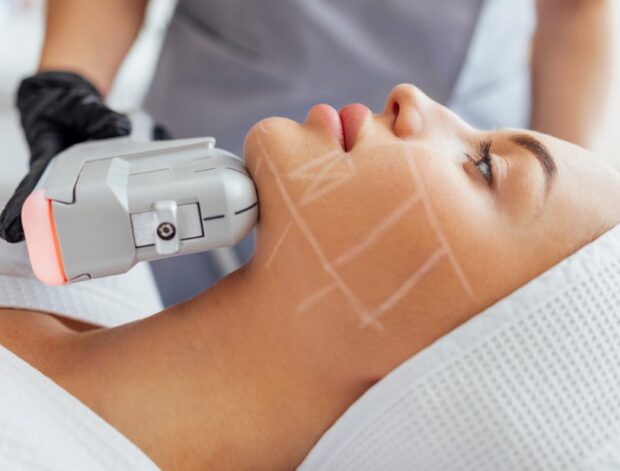
Months 3-6 represent when Type III collagen converts to stronger Type I collagen. Lifting and tightening effects may be more evident during this period. The treatment area may exhibit improved elasticity, firmness, and overall contour refinement.
Months 6-12 maintain plateau phase where results may remain stable. Collagen remodeling continues at a slower pace while the structural improvements persist. Regular skincare and sun protection during this period influence how well results maintain.
Months 12-18 show gradual decline as natural aging processes resume. The lifted appearance softens progressively, though skin quality improvements often persist longer than the lifting effect. Individual variation in this decline phase depends on multiple biological and lifestyle factors.
Factors Affecting HIFU Longevity
Age and Baseline Skin Condition
Patients in their 30s-40s with mild laxity experience longer-lasting results compared to those over 60 with moderate to severe sagging. Younger skin contains more functional fibroblasts that respond to thermal stimulation. The existing collagen matrix in younger patients provides structural support for newly formed collagen fibers.
Baseline skin thickness influences energy penetration and heat distribution. Thicker skin requires higher energy levels for results but often maintains improvements longer. Thin, fragile skin may show initial results that fade more quickly due to limited collagen reserves.
Previous sun damage impacts result duration. Photodamaged skin with compromised collagen structure shows improvement but may require more frequent maintenance. The degree of elastosis—abnormal elastic fiber accumulation from UV exposure, correlates inversely with result longevity.
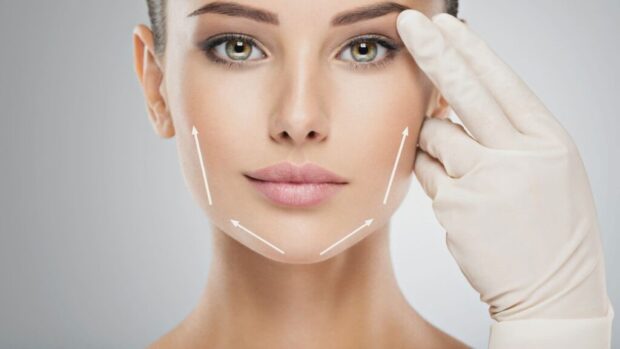
Treatment Parameters
Energy levels between 0.25-1.2 joules determine treatment depth penetration and tissue response intensity. Higher energy creates more pronounced collagen remodeling but requires careful calibration to avoid adverse effects. Energy selection should balance efficacy with safety based on individual skin characteristics.
Shot density, the number of ultrasound pulses per treatment area, affects result comprehensiveness. Standard protocols deliver 300-500 shots for lower face, 800-1200 for full face, and 200-300 for neck treatment. Higher density treatments create more uniform results that typically last longer.
Treatment depth customization targets specific tissue layers. The 1.5mm transducer addresses superficial wrinkles, 3.0mm targets dermal laxity, and 4.5mm reaches the SMAS layer. Combining multiple depths creates synergistic effects that enhance both immediate and long-term outcomes.
Practitioner technique influences energy delivery precision and treatment coverage. Consistent transducer contact, coupling gel application, and systematic treatment patterns help ensure uniform results. Overlapping treatment zones by 10-20% prevents gaps that could compromise longevity.
Biological Response Variations
Collagen synthesis capacity varies between individuals based on genetic factors, hormonal status, and metabolic health. Some patients demonstrate fibroblast activity that sustains results beyond 18 months, while others show declining response after 12 months.
Hormonal changes particularly affect women during perimenopause and menopause. Declining estrogen reduces collagen production rate and skin thickness. Hormone replacement therapy may extend HIFU results by maintaining skin’s regenerative capacity.
Metabolic factors including diabetes, thyroid disorders, and nutritional deficiencies impair wound healing and collagen formation. Addressing these conditions before treatment improves both initial response and result longevity.
Inflammatory conditions and autoimmune disorders affect tissue healing response. While not contraindications for HIFU, these conditions may necessitate modified protocols and more frequent maintenance treatments.
Lifestyle Factors That Impact Duration

Sun Protection and Skincare
Daily broad-spectrum SPF 30-50 application prevents UV-induced collagen degradation that accelerates result deterioration. Infrared and visible light protection through tinted sunscreens provides benefit. Reapplication every 2 hours during sun exposure maintains protective efficacy.
Retinoid use stimulates ongoing collagen production that complements HIFU results. Tretinoin or retinol products applied nightly enhance skin turnover and maintain treatment benefits. Starting retinoids 4 weeks post-treatment avoids interference with initial healing. A healthcare professional can advise on appropriate concentrations and usage.
Vitamin C serums protect against oxidative damage while supporting collagen synthesis. Morning application under sunscreen provides antioxidant protection throughout the day.
Peptide-containing moisturizers signal continued collagen production. Products containing matrikines like palmitoyl pentapeptide-4 and copper peptides applied twice daily support the skin’s structural matrix between treatments.
Nutrition and Hydration
Adequate protein intake provides amino acids for collagen synthesis. Glycine, proline, and hydroxyproline found in bone broth, fish, and lean meats directly support collagen formation. A healthcare professional can advise on appropriate protein requirements.
Vitamin C consumption through citrus fruits, berries, and vegetables enables hydroxylation reactions for stable collagen formation. Daily intake maintains adequate levels for collagen synthesis.
Omega-3 fatty acids from fish oil or algae supplements reduce inflammation that degrades collagen. These supplements support skin barrier function and cellular repair processes. Consult a healthcare professional for appropriate dosing.
Adequate hydration maintains skin turgor and supports nutrient delivery to treated tissues. Proper hydration improves skin plumpness and enhances HIFU results.
Habits That Accelerate Result Decline
Smoking reduces oxygen delivery to tissues and generates free radicals that destroy collagen. Nicotine constricts blood vessels, impairing nutrient delivery for maintaining HIFU results. Smokers typically experience shorter result duration.
Excessive alcohol consumption dehydrates skin and triggers inflammation. Chronic alcohol use depletes vitamin A and impairs liver function, both important for skin health. Limiting intake preserves treatment benefits.
Insufficient sleep increases cortisol levels that break down collagen. Poor sleep quality reduces growth hormone secretion necessary for tissue repair. Consistent sleep schedules optimize the body’s regenerative processes.
High-sugar diets accelerate glycation, sugar molecules binding to collagen fibers, creating rigid, dysfunctional proteins. Limiting refined sugars and high-glycemic foods preserves collagen flexibility and extends HIFU results.
Maintenance Strategies
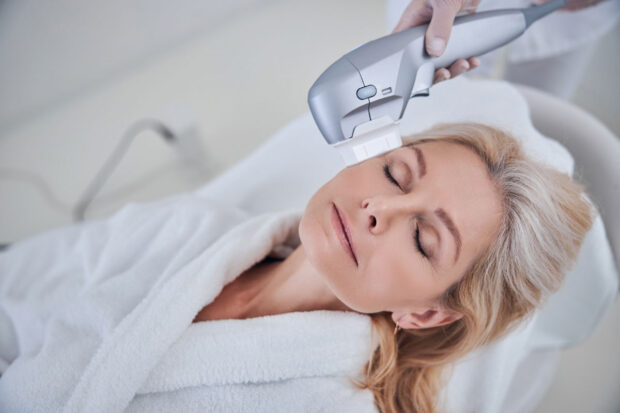
Touch-Up Treatments
Annual touch-up sessions using 50-70% of initial treatment intensity may help maintain lifted appearance. These maintenance treatments typically require fewer shots focused on areas showing early descent.
Targeted zone treatments every 6-8 months may address specific concerns like jowling or neck laxity. Concentrating energy on problem areas may extend results without full-face treatment costs or downtime.
Combination protocols alternating HIFU with radiofrequency or thread lifts may create improvements. Spacing treatments 3-4 months apart allows complete healing while maintaining collagen stimulation.
Complementary Treatments
Dermal fillers may restore volume loss that HIFU cannot address. Strategic placement in temples, cheeks, and chin may enhance the lifting effect while extending perceived results. Hyaluronic acid fillers integrated 2-4 weeks post-HIFU may create synergy.
Botulinum toxin injections may reduce dynamic wrinkles and prevent repetitive muscle movements that counteract lifting. Treating glabella, forehead, and crow’s feet every 3-4 months may maintain smooth skin surface while HIFU addresses deeper laxity.
Chemical peels using glycolic, lactic, or TCA acids may improve skin texture and stimulate superficial collagen. Monthly light peels or quarterly medium-depth peels may complement HIFU’s deeper effects.
Microneedling with radiofrequency combines mechanical and thermal stimulation for enhanced collagen production. Treatments every 6-8 weeks between HIFU sessions may maintain continuous skin rejuvenation.
Did You Know?
HIFU technology was originally developed for tumor ablation in the 1950s. The controlled application for aesthetic purposes emerged after researchers observed skin tightening in patients receiving focused ultrasound therapy for deeper tissues.
What an Aesthetic Doctor Says

HIFU longevity depends significantly on treatment customization. Energy levels, shot patterns, and depth selection are adjusted based on individual skin thickness, laxity degree, and anatomical variations. Patients maintaining results beyond 18 months typically combine appropriate treatment parameters with consistent skincare and healthy lifestyle choices.
HIFU provides natural-looking improvements rather than a dramatic transformation. Patients seeking surgical-level results may find satisfaction combining HIFU with other modalities or considering surgical options. However, for those wanting non-invasive rejuvenation with no downtime, HIFU offers outcomes when appropriately executed.
Putting This Into Practice
- Schedule your HIFU facelift treatment during a period when you can maintain consistent skincare for 6 months post-procedure, as this initial period may influence long-term outcomes
- Consider discussing collagen-supporting supplements (Vitamin C, zinc, copper) with a healthcare professional 4 weeks before treatment
- Document your results with standardized photos at day 1, week 4, month 3, and month 6 to track changes and discuss maintenance timing with your practitioner
- Develop a comprehensive skincare routine incorporating retinoids, vitamin C, and peptides starting 1 month post-treatment as advised by your healthcare provider
- Discuss maintenance treatment timing with your practitioner based on your individual response—some may benefit from treatments at 12-18 month intervals
When to Seek Professional Help
- Asymmetric results persisting beyond 2 weeks post-treatment
- Unexpected swelling or bruising lasting more than 7 days
- Numbness or altered sensation continuing past 4 weeks
- Visible skin depressions or irregularities
- Pain extending beyond mild tenderness after 48 hours
- Results declining rapidly within 6 months of treatment
Commonly Asked Questions
[su_spoiler title=”Can I extend my HIFU results beyond 18 months?” style=”fancy”]
While individual biology determines duration, combining annual touch-ups with complementary treatments like radiofrequency or threads may help maintain improvements. Skincare and lifestyle habits can influence how long results persist between sessions.
[/su_spoiler]
[su_spoiler title=”Why did my friend’s HIFU last 2 years while mine only lasted 12 months?” style=”fancy”]
Individual collagen synthesis rates, skin thickness, age, and lifestyle factors create variation in result duration. Younger patients with thicker skin, collagen production, and sun protection habits may experience different outcomes.
[/su_spoiler]
[su_spoiler title=”Should I wait until my HIFU results completely fade before retreating?” style=”fancy”]
Maintaining results may require treatment before complete resolution. Some practitioners suggest touch-ups when some of the initial improvement diminishes, typically around the 12-month mark, to maintain benefits.
[/su_spoiler]
[su_spoiler title=”Does combining HIFU with other treatments extend the results?” style=”fancy”]
Complementary treatments may create effects that enhance and prolong HIFU outcomes. Combination with fillers, botulinum toxin, and energy-based devices addresses multiple aging factors simultaneously.
[/su_spoiler]
[su_spoiler title=”Will repeated HIFU treatments damage my skin long-term?” style=”fancy”]
Properly spaced treatments (minimum 12 months apart for full treatments, 6 months for touch-ups) allow tissue recovery. Following appropriate protocols, HIFU can be repeated for many years. A healthcare professional can advise on suitable treatment intervals.
[/su_spoiler]
Conclusion
HIFU results lasting 12-18 months depend on treatment parameters, age, and lifestyle factors. Maintaining results requires sun protection, proper skincare, and may benefit from touch-up treatments at 12-18 month intervals. Individual response varies based on collagen synthesis capacity and baseline skin condition.
If you’re experiencing skin laxity or considering HIFU treatment, MOH-accredited aesthetic doctors can evaluate your condition and develop a customized treatment plan.

